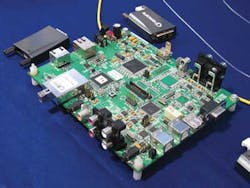TRADESHOW REVIEW: New products and technologies emerge at The Vision Show
Visitors to The Vision Show in May 2012, held in Boston, were not met with a lack of new products and technologies from many well-established imaging companies exhibiting on the floor. What was perhaps most notable was the number of less well-known companies that decided to showcase their latest cameras, frame grabbers, software, and machine-vision systems.
While companies such as SICK and LMI Technologies demonstrated their structured-light-based 3-D camera systems, Numetrix debuted what may well be the world's fastest phase-projection 3-D scanners capable of capturing images at speeds as fast as 2.2 m/sec (see "Digitizer captures 3-D images at fast data rates").
Those seeking high-speed linescan cameras for web applications were also not to be disappointed. In many high-speed web applications, relatively short integration times will lower the achievable dynamic range. To overcome this challenge in its latest EliiXA+ 16k CMOS linescan camera, e2v has developed a 16k × 4-pixel time-delay integration (TDI) image sensor that can be read out at speeds as fast as 100 kHz (or 1.6 Gpixels/sec) over a CoaXPress interface. To increase the signal-to-noise ratio, data from pairs of adjacent pixel sites are summed and digitized using 16k ADCs. This results in a dynamic range of 73 dB.
The visible spectrum is useful for measuring many features; however, other applications such as linescan inspection of the electro- and photoluminescence of solar panels requires a camera that operates in the near-infrared (NIR). Recognizing the expense of employing indium-gallium-arsenide (InGaAs) linescan cameras for these applications, Teledyne DALSA introduced its Piranha HS NIR, an 8k × 256-pixel TDI linescan camera, at The Vision Show. Capable of detecting wavelengths up to approximately 1150 nm, the camera's 34.3-kHz line rate is supported over a Camera Link Full interface.
A number of companies now offer converters to transmit data from Camera Link, CoaXPress, FireWire, and USB cameras over fiber interfaces at long distances. Many products are offered as fiber or coaxial converter modules that can plug directly into cameras and frame grabbers, offering the benefits of optical isolation and cable distances of several kilometers.
In its line of HDMI, Camera Link, DVI, and 3G SDI converters, OWLink developed an ASIC to reduce the size of converters to 39 × 55 mm (see figure). In addition to offering the converters to system integrators, the company has also engineered a reference design that shows designers how to develop their own products using the custom ASIC and optical transceiver.
Recognizing the need to deploy machine-vision systems in harsh environments, both Integral Technologies and Neousys took to the show floor with rugged fanless "vision platforms." On the booth at Integral Technologies, the company demonstrated its IT-CSV-PRO30 fanless Intel-based 182 × 100-mm computer, which is capable of interfacing up to four native USB 3.0 channels. The company demonstrated the product interfaced to a USB 3.0 Flea camera from Point Grey Research. Neousys also offers a rugged, fanless controller -- the Intel i7-based Nuvo-1300af. The Nuvo-1300af integrates four Gigabit Power-over-Ethernet (PoE) ports that can each deliver 15.4 W to a PoE device, such as a PoE camera.
Those wishing to deploy GigE-based systems may also want to investigate A&B Software's latest GigEVision camera software development kit (SDK). Available with either two or ten runtime licenses, the universal GigE Vision Driver and hardware-independent SDK allows developers to integrate GigE cameras from more than 15 different manufacturers into their applications in development environments that include Visual Studio, Delphi, and MATLAB.

